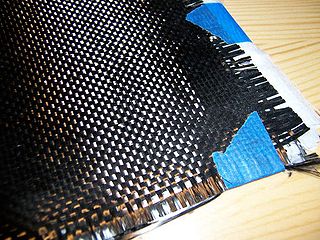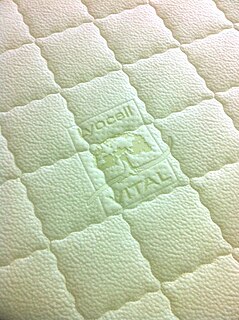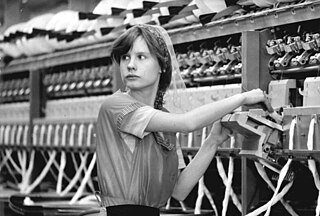Related Research Articles

Imperial Chemical Industries (ICI) was a British chemical company. It was, for much of its history, the largest manufacturer in Britain. It was formed by the merger of four leading British chemical companies in 1926. Its headquarters were at Millbank in London. ICI was a constituent of the FT 30 and later the FTSE 100 indices.

Nylon is a generic designation for a family of synthetic polymers composed of polyamides. Nylon is a silk-like thermoplastic, generally made from petroleum, that can be melt-processed into fibers, films, or shapes. Nylon polymers can be mixed with a wide variety of additives to achieve many different property variations. Nylon polymers have found significant commercial applications in fabric and fibers, in shapes, and in films.
Spinning is a twisting technique to form yarn from fibers. The fiber intended is drawn out, twisted, and wound onto a bobbin. A few popular fibers that are spun into yarn other than cotton, which is the most popular, are viscose, and synthetic polyester. Originally done by hand using a spindle whorl, starting in the 500s AD the spinning wheel became the predominant spinning tool across Asia and Europe. The spinning jenny and spinning mule, invented in the late 1700s, made mechanical spinning far more efficient than spinning by hand, and especially made cotton manufacturing one of the most important industries of the Industrial Revolution.

A spinning wheel is a device for spinning thread or yarn from fibres. It was fundamental to the cotton textile industry prior to the Industrial Revolution. It laid the foundations for later machinery such as the spinning jenny and spinning frame, which displaced the spinning wheel during the Industrial Revolution.

Carbon fibers or carbon fibres are fibers about 5 to 10 micrometers (0.00020–0.00039 in) in diameter and composed mostly of carbon atoms. Carbon fibers have several advantages: high stiffness, high tensile strength, high strength to weight ratio, high chemical resistance, high-temperature tolerance, and low thermal expansion. These properties have made carbon fiber very popular in aerospace, civil engineering, military, motorsports, and other competition sports. However, they are relatively expensive compared to similar fibers, such as glass fiber, basalt fibers, or plastic fibers.

Rayon is a semi-synthetic fiber, made from natural sources of regenerated cellulose, such as wood and related agricultural products. It has the same molecular structure as cellulose. It is also called viscose. Many types and grades of viscose fibers and films exist. Some imitate the feel and texture of natural fibers such as silk, wool, cotton, and linen. The types that resemble silk are often called artificial silk.
Synthetic fibers or synthetic fibres are fibers made by humans through chemical synthesis, as opposed to natural fibers that are directly derived from living organisms, such as plants or fur from animals. They are the result of extensive research by scientists to replicate naturally occurring animal and plant fibers. In general, synthetic fibers are created by extruding fiber-forming materials through spinnerets, forming a fiber. These are called synthetic or artificial fibers. The word polymer comes from a Greek prefix "poly" which means "many" and suffix "mer" which means "single units"..

Riley was a British motorcar and bicycle manufacturer from 1890. Riley became part of the Nuffield Organization in 1938 and was merged into the British Leyland Motor Corporation in 1968. In July 1969 British Leyland announced the immediate end of Riley production, although 1969 was a difficult year for the UK automotive industry and many cars from Riley's inventory may have been first registered in 1970.

Lyocell, originally trademarked in 1982 as Tencel, is a form of regenerated cellulose. It consists of cellulose fibers, made from dissolving pulp and then reconstituting it by dry jet-wet spinning. The fiber is used to make textiles for clothing and other purposes. Unlike rayon made by some of the more common viscose processes, lyocell production does not use carbon disulfide, which is toxic to workers and the environment.
Fibre-reinforced plastic is a composite material made of a polymer matrix reinforced with fibres. The fibres are usually glass, carbon, aramid, or basalt. Rarely, other fibres such as paper, wood, or asbestos have been used. The polymer is usually an epoxy, vinyl ester, or polyester thermosetting plastic, though phenol formaldehyde resins are still in use.

Acrylic fibers are synthetic fibers made from a polymer (polyacrylonitrile) with an average molecular weight of ~100,000, about 1900 monomer units. For a fiber to be called "acrylic" in the US, the polymer must contain at least 85% acrylonitrile monomer. Typical comonomers are vinyl acetate or methyl acrylate. DuPont created the first acrylic fibers in 1941 and trademarked them under the name Orlon. It was first developed in the mid-1940s but was not produced in large quantities until the 1950s. Strong and warm acrylic fiber is often used for sweaters and tracksuits and as linings for boots and gloves, as well as in furnishing fabrics and carpets. It is manufactured as a filament, then cut into short staple lengths similar to wool hairs, and spun into yarn.
Courtaulds was a United Kingdom-based manufacturer of fabric, clothing, artificial fibres, and chemicals. It was established in 1794 and became the world's leading man-made fibre production company before being broken up in 1990 into Courtaulds plc and Courtaulds Textiles Ltd.
Crimplene is a texturised continuous fibre launched in 1959, produced by modifying Terylene. The patent was taken out by Mario Nava of Chesline and Crepes Ltd of Macclesfield, and sold to ICI Fibres. ICI licensed the product to various throwsters. The largest producer by far was William Tatton of Leek, and the Golbourne factory was at one time capable of taking the entire output of ICI's Wilton production of Terylene.

Open-end spinning is a technology for creating yarn without using a spindle. It was invented and developed in Czechoslovakia in Výzkumný ústav bavlnářský / Cotton Research Institute in Ústí nad Orlicí in 1963.
Fine Spinners and Doublers was a major cotton spinning business based in Manchester, England. At its peak it was a constituent of the FT 30 index of leading companies on the London Stock Exchange.

The Lancashire Cotton Corporation was a company set up by the Bank of England in 1929, to rescue the Lancashire spinning industry by means of horizontal rationalisation. In merged 105 companies, ending up in 1950 with 53 operating mills. It was bought up by Courtaulds in August 1964.
John Donald Rose FRS was a British industrial chemist, who worked for Imperial Chemical Industries from 1935 to 1972. His posts at ICI included director of research and chairman of the paints division. He was also Master of the Worshipful Company of Salters.

Sir John Coldbrook Hanbury-Williams was a British businessman and courtier. He was director of Courtaulds from 1946 to 1962, served as a director of the Bank of England from 1936 to 1963, and held various positions in the royal household.
The Millhaven Fibres Plant opened September 28, 1955 as the third polyester plant in the world. It was originally built to manufacture a new type of synthetic yarn called Terylene, which is known as Dacron in the United States. Terylene polyester fibre was invented in England in 1940 and had wide application in the apparel trade and for industrial use. In 1966, Terylene underwent a name change, to Fortrel. This happened in the same year as the plant's name being changed
Red Scar Works was built in 1939 by Courtaulds and produced rayon. It was located in Ribbleton Preston off Longridge Road. The closure of the works was announced in November 1979 and the issue raised in the UK Parliament House of Commons by the constituency MP. At the time of closure approximately 2,600 people were employed there but there were approximately 4,000 at its peak. It was the largest rayon producing site in Britain. Two main products were manufactured with one being tyre cord by a process known as CSPT - Continuous Spinning Process Tenasco. Two main denier of this product were manufactured. The other product was a general textile called Bright. A range of deniers of this were produced in a range of colours. The trade name for the coloured product was Duracol. At the time of closure, one reason given by management for the closure was the rising popularity of steel belt radial tires thus reducing demand for tyre cord.
References
Elliott, Arthur (2009), History of British Nylon Spinners, Old Bakehouse Publications, Church Street, Abertillery, NP13 1EA
- ↑ Historybook Archived 6 July 2011 at the Wayback Machine AkzoNobel, p 235
- ↑ The Times, 3 January 1940, pg. 12
- ↑ The Times, 15 March 1940, pg. 3
- 1 2 Elliott page 5
- ↑ The Times, 12 March 1941, pg. 9
- ↑ Elliott pp 6,7
- ↑ The Times, 20 March 1945, pg. 7
- ↑ Elliott p7
- ↑ The Times, 5 November 1945, pg. 7
- ↑ The Times, 9 May 1947, pg. 10
- ↑ The Times, 12 July 1948, pg. 8
- 1 2 Elliott p 21/2
- ↑ The Times, 5 July 1949, pg. 8
- ↑ Elliott p 8
- ↑ The Times, 1 February 1949, pg. 7
- ↑ The Times, 6 June 1950, pg. 8
- ↑ The Times, 4 July 1950, pg. 8
- ↑ The Times, 10 July 1951, pg. 9; also 13 July pg. 9
- ↑ The Times, 8 July 1952, pg. 10
- ↑ The Times, 16 October 1952, pg. 3
- ↑ The Times, 17 October 1952, pg. 11
- ↑ The Times, 24 June 1954, pg. 4
- ↑ The Times, 10 July 1954, pg. 5
- ↑ The Times, 9 June 1953, pg. 4
- ↑ The Times, 12 February 1954, pg. 5
- ↑ The Times, 15 April 1954, pg. 8
- ↑ Elliott pages 64, 76, 77, 86, 88
- ↑ The Times, 14 January 1957, pg. 11
- ↑ The Times, 22 May 1957, pg. 15
- ↑ The Times, 25 September 1957, pg. 6
- ↑ The Times, 16 December 1957, pg. 11
- ↑ The Times, 9 April 1958, pg. 5
- ↑ The Times, 16 August 1958, pg. 4
- ↑ The Times, 18 September 1958, pg. 3
- ↑ The Times, 19 September 1958, pg. 16
- ↑ The Times, 14 October 1958, pg. 13
- ↑ The Times, 10 October 1958, pg. 5
- ↑ The Times, 12 September 1958, pg. 5
- ↑ The Times, 24 May 1962, pg. 8
- ↑ The Times, 12 May 1972, pg. II
- ↑ Elliott page 112
- ↑ Elliott, Chapter 9, pp 92–98
- ↑ Chem. Eng. News, 22 January, page 21; 29 January, pp 25–26; 26 March, pp 25–29, 1962
- ↑ Keesing's Record of World Events (formerly Keesing's Contemporary Archives), Volume 10 (1964), Jul 1964 United Kingdom, page 20162